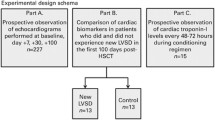Abstract
Acute rejection is a frequent consequence after heart transplantation. To expand our knowledge of the rejection process and to investigate some intragraft events during acute rejection, the following experimental transplantation model was designed. Right cervical heart transplantation was performed in 12 mongrel dogs. Two experimental groups of six animals each received different immunosuppressive regimens. All animals were treated with daily triple drug therapy. In contrast to group 1, the animals in group 2 received high-dose steroids during rejection. The condition of the hearts was examined by daily transmural biopsies, graded according to the Billingham classification. To detect and quantify alterations in the mononuclear cell subsets of the myocardial venous return, blood samples from the coronary sinus blood (CS) and from peripheral blood (PB) were taken simultaneously with the biopsy. The total number of lymphoblasts and activated lymphocytes was determined and an activation index (AI) was calculated. The data referred to was established from 337 transmural biopsies. The AI of PB (n=287) correlated well with the different stages of acute rejection (grade B0: AI=2.2±2.1; grade B1+2: AI=6.3±1.7; grade B3: AI=10.0±4.7; P<0.001). The rejection kinetics of both groups, including the rejection-free interval following high-dose steroid administration in group 2, could be expressed accurately by the AI. The time course of the total number of lymphoblasts in CS versus PB demonstrated that the lymphoproliferative response started 4 days prior to the first intramyocardial signs of rejection (x = 3.8 ± 0.7; n=12). The maximum number of lymphoblasts was seen on the day of rejection in group 1 and 1 day after the onset of histologically proven rejection in group 2 (group 1: n=6: CS x = 40.1 ± 7.5; PB x = 12.2 ± 4.1; P<0.001; group 2: n=6: CS x = 39.4 ± 8.8; PB x = 12.9 ± 3.7; P<0.001). Under rejection therapy in group 2 these cells decreased immediately, followed by a short rejection-free interval. In group 1 the total number of lymphoblasts diminished continuously, almost reaching the nuber in PB at the time of final rejection. In contrast, activated lymphocytes did not render adequate results. Comparison of daily histology and the data of PB proved there is a good correlation between the AI and the different histologic stages of acute rejection. The total number of lymphoblasts in CS during rejection is significantly higher than in PB. Acute rejection seems to be detectable almost 4 days before histology and PB cytology by cytologic evaluation of the CS. Therefore, we speculate that the differentation and proliferation of lymphoblasts during the initial phase of acute rejection takes place within the graft itself.
Similar content being viewed by others
References
Angermann C, Spes C, Hart J, Kemkes B, Gokel J (1989) Echocardiographic diagnosis of acute rejection in heart transplant recipients on cyclosporine. Z Kardiol 78: 243–252
Ascher N, Hoffman R, Hanto D, Simmons R (1984) Cellular basis of allograft rejection. Immunol Rev 77: 217–232
Billingham ME (1982) Diagnosis of cardiac rejection by endomyocardial biopsy. J Heart Lung Transplant 1: 25–30
Billingham ME, Cary NRB, Hammond ME, Kemnitz J, Marboe C, McAllister M, Snovar D, Winters G, Zerbe A (1990) A working formulation for the diagnosis of heart and lung rejection: heart rejection study group. J Heart Transplant 6: 587–593
Ertel W, Reichenspurner H, Lersch C, Hammer C, Pahl M, Lehmann M, Kemkes BM, Osterholzer G, Reble B, Reichart B, Brendel W (1985) Cytoimmunologic monitoring in acute rejection and viral, bacterial or fungal infection following transplantation. J Heart Lung Transplant 4: 390–393
Haberl R, Weber M, Reichenspurner H, Kemkes B, Osterholzer G, Anthuber M, Steinbeck G (1987) Frequency analysis of the surface electrocardiogram for recognition of acute rejection after orthotopic cardiac transplantation in man. Circulation 76: 101–108
Hammer C, Reichenspurner H, Ertel W, Lersch C, Pahl M, Brendel W, Reichart B, Überfuhr P, Welz A, Kemkes B, Reble B, Funccius W, Gokel M (1984) Cytological and immunologic monitoring of cyclosporine-treated human heart recipients. J Heart Lung Transplant 3: 228–233
Hanson C, Bolling S, Stoolman L, Schlegelmilch J, Abrahms G, Mirka P, Deeb G (1987) Cytoimmunologic monitoring and heart transplantation. J Heart Lung Transplant 7: 424–429
Holzinger C, Zuckermann A, Laczkovic A, Seitelberger R, Laufer G, Kirk M, Wolner E (1990) Monitoring of mononuclear cells from coronary sinus and right atrium blood in patients following heart transplantation (abstract). Thorac Cardiovasc Surg 38: 22
Jutte N, Daane R, Bemd J van den, Hop W, Essed C, Simoons M, Bos E, Weimar W (1989) Cytoimmunological monitoring to detect rejection after heart transplantation. Transplant Proc 21:2519–2520
Mann F, Priestley J, Markowitz J, Yater W (1933) Transplantation of the intact mammalian heart. Arch Surg 26: 219–223
Orosz C, Zinn N, Sirinek L, Ferguson R (1986) In vivo mechanisms of alloreactivity. Transplantation 41: 84–92
Pedersen N, Morris P (1970) The role of the lymphatic system in the rejection of homografts: a study of lymph from renal transplants. J Exp Med 131: 936–942
Schütz A, Brandl U, Breuer M, Engelhardt, M, Sendelhofert A, Hammer C, Reichart B, Kemkes BM (1992) Time course and morphology of acute rejection in heterotopic transplanted hearts. In: Shapira Z, Yussim A, Hammer C (eds) Transplant monitoring. W. Pabst, Munich, pp 206–218
Author information
Authors and Affiliations
About this article
Cite this article
Breuer, M., Schütz, A., Engelhardt, M. et al. Intragraft events after heart transplantation: an experimental study comparing cytology in coronary sinus blood, peripheral blood, and daily histology. Transpl Int 7, 22–26 (1994). https://doi.org/10.1007/BF00335659
Received:
Revised:
Accepted:
Issue Date:
DOI: https://doi.org/10.1007/BF00335659




